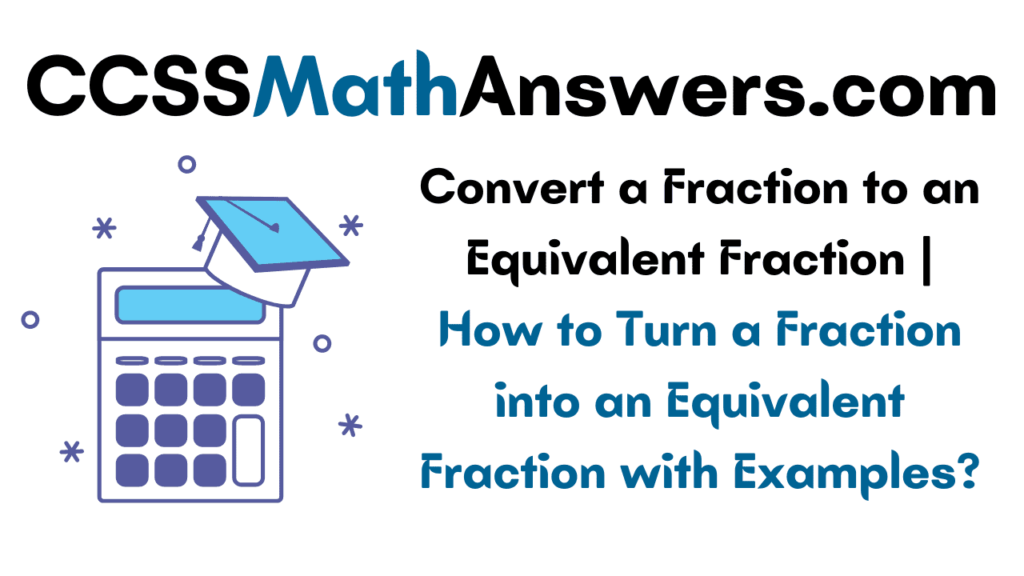Do you want to know how to convert a fraction to an equivalent fraction? You will find all the information regarding Equivalent Fractions such as the Definition, Procedure on How to convert a fraction to an equivalent fraction, etc. You can also check the solved examples of converting a fraction to an equivalent fraction explained step by step so that you can understand them easily.
Read More:
Equivalent Fraction – Definition
If two or more fractions on simplification results in the same value then they are said to be Equivalent Fractions. Consider an example \(\frac{2} {4}\), \(\frac{3} {6}\). These two on simplification results in the fraction value \(\frac{1} {2}\). As both of them have the same fractional value on simplification they are said to be Equivalent Fractions.
How to Verify if Two Fractions are Equivalent or Not?
To verify whether the two fractions are equivalent or not, multiply the numerator of one fraction by the denominator of another fraction. Also, multiply the denominator of one fraction by the numerator of another fraction. If the products are the same after the multiplication then the fractions are said to be equivalent.
How do you Turn a Fraction into an Equivalent Fraction?
Follow the simple measures listed below in order to change a fraction into an equivalent fraction. They are along the lines
- You can make Equivalent Fractions either by multiplying or Dividing the Numerator and Denominators with the Same Amount.
- Doing so, will not alter the value of the fraction. However, we can’t Perform Addition and subtraction as they may alter the value of the fractions.
- Simplify as much you can till both the Numerator and Denominator stay Whole Numbers.
How to Convert a Fraction to an Equivalent Fraction with a Large Denominator?
If we multiply the numerator and the denominator of the fraction with the same number the value of the fraction doesn’t change and we get the equivalent fraction.
Example 1:
Consider the fraction \(\frac { 1 }{ 4 } \) and find the equivalent fraction.
Solution:
Multiply with 2 to get equivalent fraction.
\(\frac { 1×2 }{ 4×2 } \) =\(\frac { 2 }{ 8 } \)
The equivalent fraction of \(\frac { 1 }{ 4 } \) is \(\frac { 2 }{ 8 } \)
Example 2:
consider the fraction \(\frac { 3 }{ 8 } \)
Solution:
Multiply with 5 to get an equivalent fraction.
\(\frac { 3×5 }{ 8×5 } \)=\(\frac { 15 }{ 40 } \)
The equivalent fraction of \(\frac { 3 }{ 8 } \) is \(\frac { 15 }{ 40 } \)
How to Convert a fraction to an equivalent fraction with the smaller denominator
If the numerator and the denominator of the fraction are divided by the same number then the value of the fraction doesn’t change and we will get an equivalent fraction.
Examples on Converting a Fraction to an Equivalent Fraction with the Smaller Denominator
Example 1:
Consider the fraction \(\frac { 15 }{ 75 } \) find the equivalent fraction.
Solution:
Divide with 5 to get the equivalent fraction.
\(\frac { 15÷5 }{ 75÷5 } \)=\(\frac { 3 }{ 15 } \)
The equivalent fraction of \(\frac { 15 }{ 75 } \) is \(\frac { 3 }{ 15 } \).
Example 2:
Consider the fraction \(\frac { 10 }{ 28 } \) find the equivalent fraction.
Solution:
Divide with 2 to get the equivalent fraction.
\(\frac { 10÷2 }{ 28÷2} \)=\(\frac { 5 }{ 14 } \)
The equivalent fraction of \(\frac { 10 }{ 28 } \) is \(\frac { 5 }{ 14 } \).
